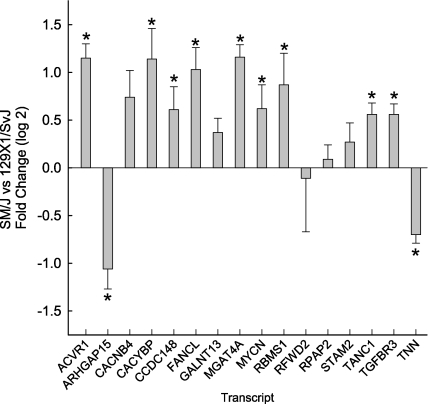Figure 5.
Assessment of basal transcript levels of 16 candidate genes for acrolein-induced acute lung injury in mice. Mice were exposed to filtered air (control) and lung mRNA isolated. Basal transcript levels of SM/J (sensitive) mouse strain were compared with those of 129X1/SvJ (resistant) mouse strain as determined by quantitative real-time polymerase chain reaction. Values are mean ± SE of the transcript level of SM/J (n = 8) as compared with the 129X1/SvJ (n = 8). *Significantly different between the sensitive SM/J and resistant 129X1/SvJ mouse strain as determined by analysis of variance with an all pairwise multiple comparison procedure (Holm-Sidak method). ACVR1 = activin A receptor, type 1; ARHGAP15 = Rho GTPase activating protein 15; CACNB4 = calcium channel, voltage-dependent, β 4 subunit; CACYBP = calcyclin binding protein; CCDC148 = coiled-coil domain containing 148; FANCL = Fanconi anemia, complementation group L; GALNT13 = UDP-N-acetyl-α-D-galactosamine:polypeptide N-acetylgalactosaminyl transferase 13; MGAT4A = mannoside acetylglucosaminyltransferase 4, isoenzyme A; MYCN = v-myc myelocytomatosis viral related oncogene, neuroblastoma derived (avian); RBMS1 = RNA binding motif, single stranded interacting protein 1; RFWD2 = Ring finger and WD repeat domain 2; RPAP2 = RNA polymerase II associated protein 2; STAM2 = signal transducing adaptor molecule (SH3 domain and ITAM motif) 2; TANC1 = tetratricopeptide repeat, ankyrin repeat and coiled-coil containing 1; TGFBR3 = transforming growth factor, β receptor III; TNN = tenascin N.

